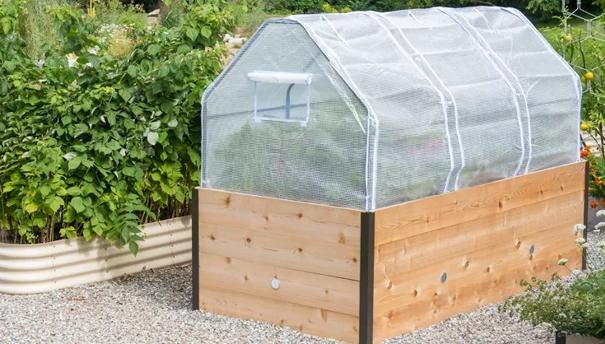If you are like me, this time of year you can't get enough garden-fresh vegetables. Spring and summer harvests make for great salads, but nothing enhances the flavor of a fall bounty like soup.
I used to think that soup was made by combining leftover scraps, vegetable peelings and any surplus from the garden into a big pot with water. It took me a while to master the art of soup-making, but now that I understand the basic formula, I can be daring. I've learned that there are three main types: pur饳, chunky soups and chowders, that can feature a range of different vegetables in endless variations.
Just as a good gardener makes gardening look easy, the same is true for cooks who know how to make soup. It takes practice and a certain level of skill to know what goes together naturally and in what order. For instance, adding herbs at the last minute so they are fresh-tasting, yet don't overpower; and simmering vegetable chunks just long enough to turn them tender. It takes a sense of timing that can't be taught in a recipe.
 Golden Tomato Gazpacho
Golden Tomato GazpachoGolden Tomato Gazpacho
This chilled soup involves no cooking, so you won't heat up the kitchen. If you don't have yellow tomatoes, it is equally delicious made with any garden-ripe tomatoes. It can be served for lunch or a light dinner, along with garlic bread and a savory tart. Serves 6
- 2 yellow Persimmon tomatoes
- 1 ripe peach, peeled
- 1/4 cup orange juice
- 1 sweet bell pepper, coarsely chopped
- 1 cucumber, peeled and coarsely chopped
- 1/2 sweet onion, finely chopped
- 1 clove garlic, minced
- 1/4 cup sweet basil leaves
- 1/4 cup olive oil
- 1/4 cup red wine vinegar
- 1/2 small red cayenne pepper
Peel and quarter the tomatoes and the peach and place in a blender.
Add the orange juice, peppers, cucumber, onion and garlic. Pulse to coarsely chop.
Add the basil, olive oil, vinegar, pepper and pulse to blend, until smooth or keep a few chunks for texture.
Cover and refrigerate until well-chilled, at least 1 hour. Garnish with croutons and edible flowers, such as nasturtiums, chive blossoms, calendula petals or Johnny jump-ups
Learning the Foundations
With soup, you can follow a recipe, or you can get creative. Because I'm a gardener, I like to compare making soup to arranging flowers. I choose a few large flowers to serve as the focal point and provide substance, then add fillers that offer support. When I start a soup, I select the main vegetable that dominates and defines the character, then add a range of supporting vegetables and herbs that provide flavor accents.
Spontaneity in the kitchen is essential. I sometimes flavor soups with Champagne instead of chicken stock; I use pur饤 peaches instead of carrots, or make chowder out of zucchini instead of corn. To add more depth to the flavors, I often roast the vegetables before adding them to the pot. My technique: In a roasting pan, spread the vegetables in a single layer and roast in a 400-degree oven until slightly singed and soft, about one hour.
To get you started in creative soup-making, here are my three favorite types:
Purees
A vegetable puree is the simplest kind of soup to make, but it can quickly become a melange of vegetables, which makes it less interesting. To keep the flavors clean, focus on one or two vegetables, such as winter squash and carrots, or leeks and potatoes. Because pureed soups can look a bit bland, be ready with garnishes, such as a dab of cr譥 fraiche, fresh herbs or edible flowers.
To start, melt a small knob of butter or a few tablespoons of oil in a stockpot, saut頯nions and garlic until translucent, then add coarsely chopped vegetables, stirring frequently for about 5 minutes to slightly soften and merge all the flavors. Add enough water or broth to cover, and simmer until vegetables are soft, testing with a fork or knife. Turn off the heat, and either use an immersion blender or transfer to a blender and puree until smooth. Adding cream or yogurt is optional, as is tossing in a handful of fresh spinach to add color.
 Using ingredients from her backyard garden, Suzanne DeJohn created this soup, which features homegrown tomatoes, chard, leeks, potatoes and carrots.
Using ingredients from her backyard garden, Suzanne DeJohn created this soup, which features homegrown tomatoes, chard, leeks, potatoes and carrots.Stock and Chunky Soups
Stock is the flavor foundation to most soups and essential in a simple chunky soup. Made by simmering vegetables or chicken in a stock pot, the most basic ingredients are onions, carrots, celery, garlic and leeks. To avoid a heavy hand with herbs, use a bundle of herbs, known as a bouquet garni, which is traditionally made by wrapping together sprigs of thyme, parsley and tarragon, in a fresh bay leaf tied with kitchen string. Another approach: Wrap the herbs in a loosely woven cloth bag or a piece of cheesecloth.
Once you've made a batch of aromatic stock, you can easily make a chunky soup by sauteing a blend of any chopped vegetables in butter or oil, add stock to cover, then stir in slivers of cooked chicken, rice or noodles to give it more texture. Then simmer until all is tender. Chunky soup magically takes on more flavor the longer it sits. Today the soup might be delicious, but tomorrow it will be outstanding.
Chowders
Chowder began with sailors, who used what they had aboard the ship: salt pork, biscuits and seafood. By the 1800s, milk, clams and potatoes had also been added. These days, chowders aren't limited to fish.
Chowder is any chunky soup made with vegetables and stock: corn blended with lima beans and cilantro, roasted tomatoes with fresh shelling beans, fennel and basil.
Uncooked chowders can be made into gazpacho, using ripe tomatoes, peaches, peppers and cucumbers. Chop everything into bite-sized pieces, or put larger chunks into the blender. Blend with a small amount of vegetable juice — just enough to give it a thick, soupy texture. Keep in mind that the vegetables will continue to release their own juices, so don't add too much! Transfer to a bowl or pitcher and refrigerate for an hour or two before serving.




